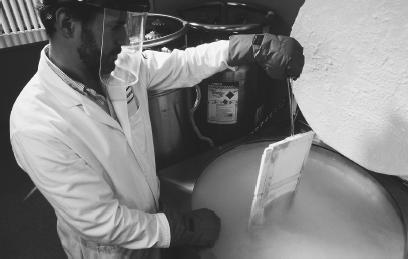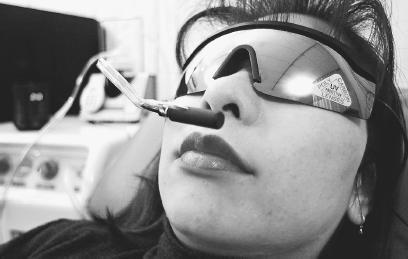Nonmetals - How it works
Defining the Nonmetals
The majority of elements on the periodic table are metals: solids (along with one liquid, mercury) which are lustrous or shiny in appearance. Metals are ductile, or malleable, meaning that they can be molded into different shapes without breaking. They are excellent conductors of heat and electricity, and tend to form positive ions by losing electrons. The vast majority of elements—87 in all—are metals, and these occupy the left, center, and part of the right-hand side of the periodic table.
With the exception of hydrogen, placed in Group 1 above the alkali metals, the nonmetals fill a triangle-shaped space in the upper right corner of the periodic table. All gaseous elements are nonmetals, a group that also includes some solids, as well as bromine, the only element other than mercury that is liquid at room temperature. In general, the nonmetals are characterized by properties opposite those of metals. They are poor conductors of heat and electricity (though carbon, a good electrical conductor, is an exception), and they tend to form negative ions by gaining electrons. They are not particularly malleable, and whereas most metals are shiny, nonmetals may be dull-colored, black (in the case of carbon in some forms or allotropes), or invisible, as is the case with most of the gaseous nonmetals.
Grouping the Nonmetals
Whereas the metals can be broken down into five families, along with seven "orphans"—elements that do not fit into a family grouping—the nonmetals are arranged in two families, as well as eight "orphans." Hydrogen, because of its great abundance in the universe and its importance to chemical studies, is addressed in a separate essay within this book. The same is true of carbon: though not nearly as abundant as hydrogen, carbon is a common element of all living things, and therefore it is discussed in the essay on Carbons and Organic Chemistry.

The other six "orphan" nonmetals, which will be examined in detail later in this essay, are listed below by atomic number:
- 5. Boron (B)
- 7. Nitrogen (N)
- 8. Oxygen (O)
- 15. Phosphorus (P)
- 16. Sulfur (S)
- 34. Selenium (Se)
THE NOBLE GASES.
The noble gases, discussed in detail within an essay devoted to that subject, are listed below by atomic number:
- 2. Helium (He)
- 10. Neon (Ne)
- 18. Argon (Ar)
- 36. Krypton (Kr)
- 54. Xenon (Xe)
- 86. Radon (Rn)
Occupying Group 8 of the North American periodic table, the noble gases—with the exception of helium—have valence electron configurations of ns 2 np 6 . This means that they have two valence electrons (the electrons involved in chemical bonding) on the orbital designated as s, and six more on the p orbital. As for n, this designates the energy level, a number that corresponds to the period or row that an element occupies on the periodic table.
Most elements bond according to what is known as the octet rule, forming a shell composed of eight electrons. Since the noble gases already have eight electrons on their shell, they tend not to bond with other elements: hence the name "noble," which in this context means "set apart." Helium, on the other hand, has a valence shell of s 2 ; however, it too is characterized by a lack of reactivity, and therefore is included in the noble gas family. Noble gases are all monatomic, meaning that they exist as individual atoms, rather than in molecules. To put it another way, their molecules are single atoms. (By contrast, atoms of oxygen, for instance, usually combine to form a diatomic molecule, designated O 2 .)
Due to their apparent lack of reactivity, the noble gases—also known as the rare gases—were once called the inert (inactive) gases. Indeed, helium, neon, and argon have not been found to combine with other elements to form compounds. However, in 1962, English chemist Neil Bartlett (1932-) succeeded in preparing a compound of xenon with platinum and fluorine (XePtF 6 ), thus overturning the idea that the

THE HALOGENS.
Next to the noble gases, in Group 7, are the halogens, a family discussed in a separate essay. These are listed below, along with atomic number and chemical symbol. Note that astatine is sometimes included with the metalloids, elements that display characteristics both of metals and nonmetals.
- 9. Fluorine (F)
- 17. Chlorine (Cl)
- 35. Bromine (Br)
- 53. Iodine (I)
- 85. Astatine (At)
The halogens all have valence electron configurations of ns 2 np 5 : in other words, at any energy level n, they have two valence electrons in the s orbital, and 5 in the p orbital. In terms of phase of matter, the halogens are the most varied family on the periodic table. Fluorine and chlorine are gases, iodine is a solid, and bromine (as noted earlier) is one of only two elements existing at room temperature as a liquid. As for astatine, it is a solid too, but so highly radioactive it is hard to determine much about its properties. (The only other nonmetal that has a large number of radioactive isotopes is the noble gas radon, considered highly dangerous.)
Though they are "next door" to the noble gases, the halogens could not be more different. Whereas their neighbors to the right are the least reactive elements on the periodic table, the halogens are the most reactive. Indeed, fluorine has the highest possible value of electronegativity, the relative ability of an atom to attract valence electrons. It is therefore one of the only elements that will bond with a noble gas.
All of the halogens tend to form salts, compounds—formed, along with water, from the reaction of an acid and base—that bring together a metal and a nonmetal. Due to this tendency, the first of the family to be isolated—chlorine, in 1811—was originally named "halogen," a combination of the Greek words halos, or salt, and gennan, "to form or generate." In their pure form, halogens are diatomic, and in contact with other elements, they form ionic bonds, which are the strongest form of chemical bond. In the process of bonding, they become negatively charged ions, or anions.
Abundance of the Nonmetals
IN THE UNIVERSE.
As is stated many times throughout this book, humans may be created equal, but the elements are not. Though 88 elements exist in nature, this certainly does not mean that each occupies a 1/88 share of the total pie. Just two elements—the nonmetals hydrogen and helium, which occupy the first two positions on the periodic table—account for 99.9% of the matter in the entire universe, yet the percentage of matter they make up on Earth is very small.
The reason for this disparity is that, whereas our own planet (as far as we know) is unique in sustaining life—requiring oxygen, carbon, nitrogen, and other elements—the vast majority of the universe is made up of stars, composed primarily of hydrogen and helium.
ON EARTH AND IN THE ATMOSPHERE.
Nonmetals account for a large portion of Earth's total known elemental mass—that is, the composition of the planet's crust, waters, and atmosphere. Listed below are figures ranking nonmetals within the overall picture of elements on Earth. The numbers following each element's name indicate the percentage of each within the planet's total known elemental mass.
- 1. Oxygen (49.2%)
- 9. Hydrogen (0.87%)
- 11. Chlorine (0.19%)
- 12. Phosphorus (0.11%)
- 14. Carbon (0.08%)
- 15. Sulfur (0.06%)
- 17. Nitrogen (0.03%)
- 18. Fluorine (0.03%)
Some of the figures above may seem rather small, but in fact only 18 elements account for all but 0.49% of the planet's known elemental mass, the remainder being composed of numerous other elements in small quantities. In Earth's atmosphere, the composition is all nonmetallic, as one might expect:
- 1. Nitrogen (78%)
- 2. Oxygen (21%)
- 3. Argon (0.93%)
- 4. Various trace gases, including water vapor, carbon dioxide, and ozone or O 3 (0.07%)
IN THE HUMAN BODY.
As noted earlier, carbon is a component in all living things, and it constitutes the second-most abundant element in the human body. Together with oxygen and hydrogen, it accounts for 93% of the body's mass. Listed below are the most abundant nonmetals in the human body, by ranking.
- 1. Oxygen (65%)
- 2. Carbon (18%)
- 3. Hydrogen (10%)
- 4. Nitrogen (3%)
- 6. Phosphorus (1.0%)
- 9. Sulfur (0.26%)
- 11. Chlorine (0.14%)
Comment about this article, ask questions, or add new information about this topic: